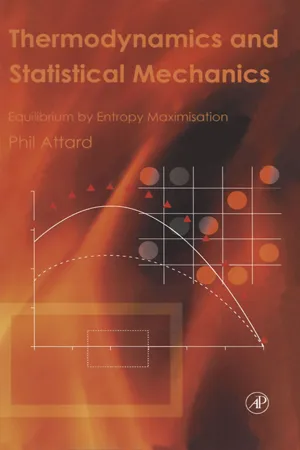Technology & Engineering
Isolated System
An isolated system is a physical system that does not exchange any matter or energy with its surroundings. This means that the total energy and matter within the system remains constant. Isolated systems are often used in thermodynamics to study the behavior of closed systems.
Written by Perlego with AI-assistance
Related key terms
Related key terms
1 of 4
Related key terms
1 of 3
3 Key excerpts on "Isolated System"
- eBook - ePub
Systems Engineering
Holistic Life Cycle Architecture Modeling and Design with Real-World Applications
- Sandra Furterer(Author)
- 2021(Publication Date)
- CRC Press(Publisher)
Systems can be open systems, where they interact with their environment. An example of an open system is a rail system, which interacts with the environment, through the rails expanding and contracting with the weather and the people running their ticket through the ticket machine. The environment does not have to be the natural environment but can be the interaction through the boundary of the system, such as the traveler interacting with the ticketing machine, that is part of the railway access system.A closed system is one that does not interact with their environment. Closed systems do not exist in nature. There are very few examples of a closed system. In thermodynamics, a closed system is one where mass is conserved within the boundaries of the system, but energy is allowed to freely enter or exit the system. In chemistry, a closed system is one in which neither reactants nor products can enter or escape. It can allow energy transfer of heat and light (Helmenstine, 2020 ).There are natural systems that exist in nature, such as a wetland. There are man-made systems, such as a bridge or a highway. There are physical systems, that exist in a physical form, such as a bridge. There are conceptual systems, that exist as an idea, such as a drawing of a bridge or a blueprint of a building. There are also static and dynamic systems. A static system has structure, such as a building, but no behavior or activity. A dynamic system has structure and behavior or activity, such as the train arriving or leaving the rail station.1.3 Defining Systems Engineering
Systems engineering, which is the subject of this book, is defined as:A transdisciplinary and integrative approach to enable the successful realization, use, and retirement of engineered systems, using systems principles and concepts, and scientific, technological, and management methods.(Fellows, 2019 )When we first start the semester in the Management of Engineering Systems course, my students, who come from a variety of engineering disciplines, including civil and environmental engineering, industrial engineering, chemical and materials engineering, mechanical engineering, and electrical and computer engineering, expect that they will be “designing” a system. As we delve further into the definition of systems engineering, and even into the application of the systems engineering tools, they begin to understand that the systems engineer and the systems engineering functions encompass the connective tissue across the systems engineering life cycle. Systems engineers don’t design the system, per se, but they help to define the systems concepts, they facilitate the collection of the customers’ and systems’ requirements, and they model the system architecture. All of those activities enable the specialty engineers to design the product and mechanical systems, the electrical systems, and the software and hardware systems. The systems engineer aids in ensuring the integration of the systems elements and the verification and validation of the systems. They identify and mitigate risk. They are involved in the systems engineering planning functions. Depending upon the specific organization, some of these activities and functions may vary, as to who performs them. - eBook - ePub
- Benjamin S. Blanchard, John E. Blyler(Authors)
- 2016(Publication Date)
- Wiley(Publisher)
system. Although this may appear to be overly simplistic, experience has indicated that people throughout the world tend to utilize the term rather loosely to describe many different situations and configurations. Further, there is a lack of consistency in the application of system engineering principles and concepts. Thus, it is important to first review a few terms to establish a baseline for further discussion.1.1.1 The Characteristics of a System
The term system stems from the Greek systēma, meaning an “organized whole.” Merriam-Webster's Collegiate Dictionary defines a system as “a regularly interacting or interdependent group of items forming a unified whole.”1 One of the early Military Standards on the subject, MIL-STD-499, defines a system as “a composite of equipment, skills, and techniques capable of performing and/or supporting an operational role. A complete system includes all equipment, related facilities, material, software, services, and personnel required for its operation and support to the degree that it can be considered a self-sufficient unit in its intended environment.”2 A more recent document, EIA/IS-632, defines a system as “an integrated composite of people, products, and processes that provide a capability to satisfy a stated need or objective.”3In the world of “semiconductor systems,” integrated chips have become so complex in both design and manufacturing that they are called, “Systems-on-Chip (SoC).” The integrated circuit in a SoC may contain digital, analog, mixed-signal, and often radio-frequency functions all on a single chip substrate. Even in the early days of the SoC, the IEEE recognized that, “the definition of the ‘system’ design and manufactured on a chip has significantly changed and expanded as did the technology, skills, tools, and methodologies required to produce it.”4 - eBook - ePub
Thermodynamics and Statistical Mechanics
Equilibrium by Entropy Maximisation
- Phil Attard(Author)
- 2002(Publication Date)
- Academic Press(Publisher)
Chapter 2Isolated Systems and Thermal Equilibrium
2.1 Definitions of Thermodynamic Quantities
The fundamental object treated by thermodynamics is the Isolated System , which is one that is closed and insulated from its surroundings so that it does not interact with them. An Isolated System may comprise two or more subsystems. Even though these subsystems interact with each other, macroscopic thermodynamics proceeds by treating them as quasi-isolated, which means that at any instant each subsystem is in a well-defined state and that its properties are the same as if it were in isolation in that state.1The state of an Isolated System is traditionally specified by the values of its energy E , volume V , and number of particles N. (For an incompressible solid, either V or N is redundant.) These variables have the important property that they do not change with time (i.e., they are conserved), so that they serve as the independent variables that specify the state of an Isolated System. These particular variables represent linear additive quantities. That is, the total energy of an Isolated System comprising a number of isolated subsystems is the sum of the energies of the subsystems, and similarly for the volume and particle number. Linear additivity is essential for the development of the formalism of thermodynamics.There are a number of other linear additive conserved quantities that could be used in addition to specify the state. If the Hamiltonian that characterises the intermolecular interactions of the system is translationally invariant, as occurs when the system is free of any external force fields, then the linear momentum is conserved. Similarly a rotationally invariant Hamiltonian implies that angular momentum is conserved. These momenta are also of course linearly additive quantities. Since most systems are enclosed in containers fixed in space, the momenta of the system itself are usually not conserved, and so these generally are not used in the macrostate specification.
Index pages curate the most relevant extracts from our library of academic textbooks. They’ve been created using an in-house natural language model (NLM), each adding context and meaning to key research topics.
Explore more topic indexes
Explore more topic indexes
1 of 6
Explore more topic indexes
1 of 4


